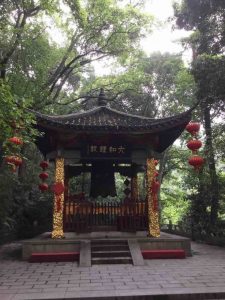 There is a park in Six Harmonious Pagoda. There is a ruin of Kaihua Temple in the park and the temple is built in the same period as Six Harmonious Pagoda. There is a terrarium excavated from the ruins of the Southern Song Dynasty. There are relics such as the Imperial Monument of the Emperor Qianlong. There is an ancient tower exhibition hall in the park. The museum introduces the origin of Six Harmonious Pagoda, the development of the past generations; the evolution of the pagoda in Chinese history; introduces the structure and interior decoration of the Six Harmonious Pagoda. This introduction will also help you have more understanding of the Six Harmonious Pagoda. The “Six Harmonious Goldfish Garden” in the park introduces that Six Harmonious Pagoda is one of the birthplaces of goldfish. In the small open space nearby, there are some statues that introduce the allusions to Six Harmonious Pagoda. Next to it is the bell of the Six Harmonious Pagoda.
There is a park in Six Harmonious Pagoda. There is a ruin of Kaihua Temple in the park and the temple is built in the same period as Six Harmonious Pagoda. There is a terrarium excavated from the ruins of the Southern Song Dynasty. There are relics such as the Imperial Monument of the Emperor Qianlong. There is an ancient tower exhibition hall in the park. The museum introduces the origin of Six Harmonious Pagoda, the development of the past generations; the evolution of the pagoda in Chinese history; introduces the structure and interior decoration of the Six Harmonious Pagoda. This introduction will also help you have more understanding of the Six Harmonious Pagoda. The “Six Harmonious Goldfish Garden” in the park introduces that Six Harmonious Pagoda is one of the birthplaces of goldfish. In the small open space nearby, there are some statues that introduce the allusions to Six Harmonious Pagoda. Next to it is the bell of the Six Harmonious Pagoda.
After visiting the Ancient Tower Pavilion and learning about Six Harmonious Pagoda, you can go to climb the tower and you can better explore and appreciate the ancient tower that was built in the Song Dynasty.
There is a security check if you take with a bag, and a lockable locker on the first floor is convenient for visitors. The steps in the tower are steep, and there are no handrails in some places. The elderly must pay special attention when you are climbing the Six Harmonious Pagoda, especially when you get off the stairs.
The Six Harmonious Pagoda has 13 floors when you look from outside, but it actually has 7 floors. On each floor, you can see from afar. The highest floor is to enjoy the sight of Hangzhou Six Harmonious Pagoda. You will see a majestic modern two-story railway and highway bridge flying over the Qiantang River. This is the first self-designed Qiantang river bridge in China’s history and it was designed and built by a famous Chinese scientist, Mr. MAO Yisheng.